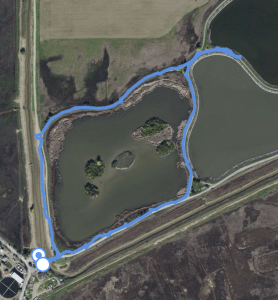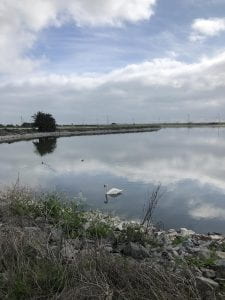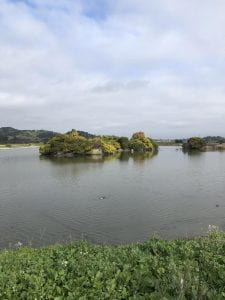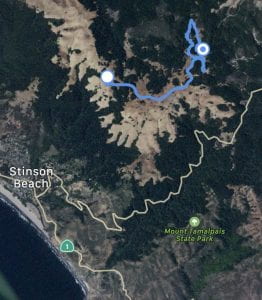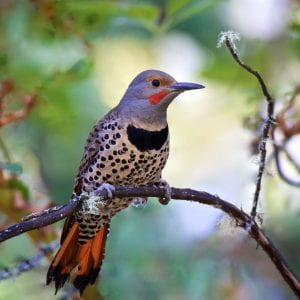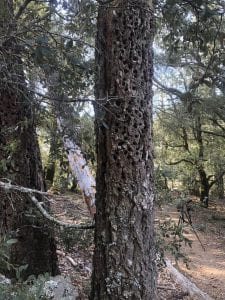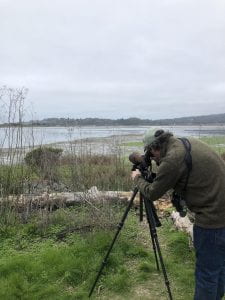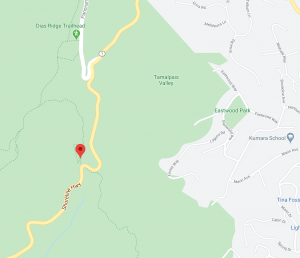Ebird List Link: https://ebird.org/checklist/S66413137
Date: 03/30/2020
Location: Presidio of San Francisco, San Fransisco County (37.78738, -122.47458) at an elevation of approximately 243 feet (74 meters). Refer to the map for where observations were recorded.
Site Description: Observations were done along a trail in the Presidio. The site consisted of a series of rolling hills at a moderate elevation. The first portion of the trail went through a forest area that contained dense amounts of tall pine and gum trees. The other portion of the trail was open-aired and covered in dense vegetation lower to the ground, for example, various types of shrubs and bushes. The most abundantly observed species were: White-crowned Sparrows (6), Common Ravens (5), American Crows (4), Swallow species (4), Anna’s Hummingbirds (3), Red-tailed Hawks (3), Stellar’s Jays (3), and Chestnut-backed Chickadees (2). Other species observed were: a Rock Pigeon (1), a Mourning Dove (1), a Turkey Vulture (1), a House Finch (1), a Fox Sparrow (1), a Song Sparrow (1), and an unidentified Sparrow species (1).
Species Account: Several types of sparrow species were located low to the ground on the first portion of the trail. I had some difficulty with their identification because many of them looked similar. I was able to identify many of them as White-crowned Sparrows. However, there was another single sparrow that had a more rounded and slightly larger body than the White-crowned Sparrows. I also noticed that its the plumage on its body was a browner color and had more distinct lines than the other sparrows. The major identification factor actually happened to be its behavior, the sparrow continuously kept hopping in place as it dug around in the dirt. The bird was identified as a Fox Sparrow (Passerella iliaca) are of the order Passeriformes and family Passerellidae. They are larger sized sparrows with a chunky body and darker plumage. Their plumage is noted to have thicker streaking than seen in other sparrows. The sparrows typically have a small, gray colored head. Across different regions, the Fox Sparrow’s body color can vary: bright foxy red, gray, and sooty brown. The red colored sparrows are observed primarily in eastern and northern regions. The gray and sooty brown sparrows are observed in the western regions. Their beaks are stout and they have medium length tails. Fox Sparrows typically inhabit woodlands and areas with high density of low ground vegetation. Fox Sparrows spend the majority of their time on the ground and under vegetation. They are ground foragers that eat a diet of seeds and insects. This particular species of sparrow exhibits a unique beahvior when it forages, they jump and scratch at the soil with both feet at once. The call of a Fox Sparrow is described as a rich, whistling. Males sing in the spring when they are defending their nesting territory. Fox Sparrows are a migratory bird, they breed and nest in the far north and western mountains; then will return south for the winter months. Both males and females provide food for their nestlings.


Sources:
- “Fox Sparrow – EBird.” Ebird.Org, https://ebird.org/species/foxspa. Accessed 1 April 2020.
- “Fox Sparrow – Audubon Guide to North American Birds.” Audobon.Org. https://www.audubon.org/field-guide/bird/fox-sparrow#. Accessed 22 Mar. 2020
Narrative: Observations occurred along a trail over 0.75 miles. The weather was partly cloudy with mild winds. The temperature was around 57 to 63 degrees Fahrenheit. Moderate diversity of species was observed across the area with rather low abundance of birds. This trail is frequented by people with dogs, so I imagine that the birds have learned to stay hidden and potentially off the ground. I was able to heard many different bird calls and songs, however, in the densely packed vegetation that covered the area I was unable to locate many for proper identification, ultimately leading me to miss a great number of species that were present. Over the duration of the trip (60 minutes), thirteen species were observed. I noticed that there were numerous amounts of insects across this site, for example dragonflies and bumblebees, so I expected to observe many insectivores. This was confirmed by the different species of sparrows that I saw. There were several unique beahviors of species I observered throughout my trip. The first thing I noted previously in my species account. The Fox Sparrow’s characteristic hopping while it foraged for insects on the ground helped me to identify it as different from the other sparrow species. The second thing I noticed was small birds frequently flying over my head at higher speeds in an undulating fashion. This led me to the assumption that it was some species of swallow. Unfortunately I was unable to get a good enough view of their features as they zipped by to capture their key features for identification. The third behavior helped me to identify crows from ravens. I noticed a flock of black birds flying high overhead. The birds were soaring and gliding, only beating their wings a few times every once in a while. I concluded that the species must have been a raven. I was able to confirm this when the species came a little lower to the ground, its wings were more pointed. This is different than a crow’s wings, which would be blunted and more splayed out at the wingtips.
Additonal Photos and Media:





